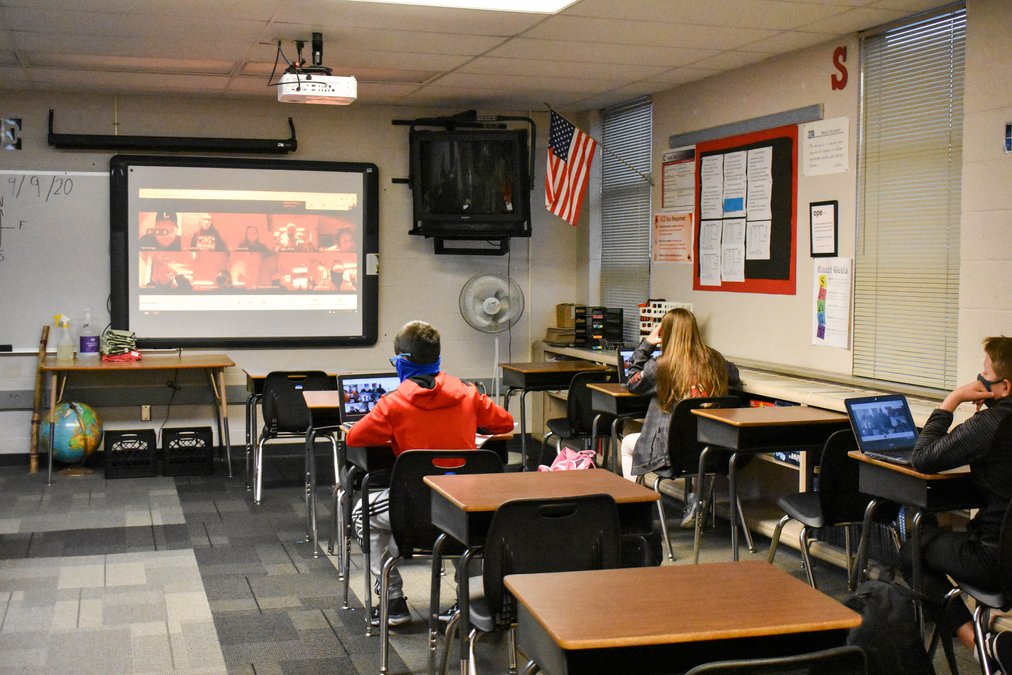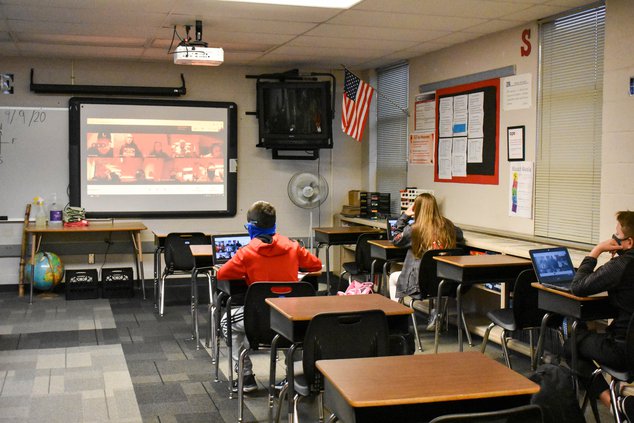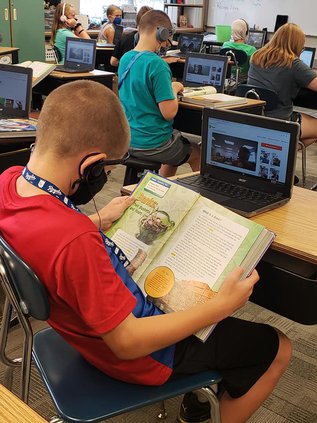The first few weeks of school at Great Bend USD 428 have gone well, Superintendent Khris Thexton told the Board of Education Monday. Students had no difficulty getting into the new routine of morning temperature checks and wearing masks for most of the day.
“They were so excited to be there – they didn’t care what they had to do to show up,” he said.
But with 245 students attending classes from home and multiple changes in the buildings, there have been plenty of adjustments. USD 428 Public Information Director Andrea Bauer provided a report on the first 2 1/2 weeks of school.
“We’re kind of affectionately calling this ‘quaran-teaching,” instead of quarantining,” Bauer said. “With exposure comes an opportunity to do things differently.”
Director of Teaching and Learning Tricia Reiser took Bauer to a classroom last week so she could see how seventh-grade teacher Tyler Rydman taught from home while he was quarantined. As he led the class from home, a substitute was in the classroom leading the technical pieces and making sure students were following the plan.
“In the classroom, the students are following along on their Chromebooks; they’re actually visiting live with their teacher who’s at home,” Bauer said. “There are also quarantined students who are at home as well so they’re joining the classroom for these pieces. It’s not ideal, and Mr. Rydman’s first piece of advice was, ‘This is not the best learning environment,’ but it’s the best that we can do at this point.”
By using Google Classroom products under the guidance of a teacher and a substitute teacher, in-person students are also becoming familiar with using their Chromebooks for homework and by doing so they will be prepared if they find themselves quarantined in the future.
“You know, teachers are being very creative,” Reiser said, describing how they collaborate on problem-solving.
For example, Reiser said Cara Negaard, who teaches family and consumer science at GBHS, was having an issue with audio. “Whenever the teacher is in the room and teaching kids remotely, being able to hear and see is a real issue,” she said. “She was able to work it out by carrying around her iPad and talking into her iPad, and using her desktop computer for projecting.”
A survey of remote learning teachers revealed some of the benefits and challenges they’ve noticed, Bauer said. “The daily connection with students is probably the strongest point – building those relationships – and parent involvement is something that they feel positive about.” The challenges have included internet issues.
“We actually purchased a number of hotspots to hand out for those that were having trouble ... or had no ability to access some kind of internet,” Superintendent Thexton said. “We still have a pretty good number of those available, so whether you’re quarantine or remote, if you need access we can help out.”
Thexton said there were technical challenges as school started and they increased on Sept. 8 which large school districts such as Wichita also started to access web-based learning platforms.
“When they jumped on, it was slowing down the systems that we were using,” Thexton said.
Assistant Superintendent John Popp described the situation. “In the classroom, you bring it up (on the screen) and you get the ‘spinning wheel,’ it’s not loading, it’s not loading. It would keep refreshing and then eventually it would come up. It just slowed things down.”
Thexton said he believes companies such as Google have since adjusted to meet the higher demand.
“When it’s working, it’s working very well,” Reiser said of GB Remote learning. “The challenges are when the moms and dads are working and they don’t have time to spend time doing what needs to be done.”
“There’s no replacement for being in the classroom,” Popp said. Parents “don’t necessarily have the educational expertise or the motivational abilities to be able to keep kids going. Even the best parents, they’re also busy doing other things as well. That’s what teachers are trained for. This is what they do. There’s just no replacement to being in the classroom, but we understand that (some students) need to be home right now for safety reasons or whatever. That’s always going to be a concern with kids who are home — are they making the progress that we really need them to make?”
Staffing remote education
Keeping a full staff has been challenging, Popp said. The district has fewer substitute teachers than in the past, and they are needed to deal with quarantine issues and everyday illnesses.
“We are trying to work with our staff and if they’re able to instruct their students from home (while on quarantine) that doesn’t necessarily hit their leave time, because they’re working and are probably working harder than if they were here in person,” he said.
“Initially, when we talked about remote, we thought maybe we’d have enough kids to free up a teacher per grade level. But it didn’t fall out that way.” Instead, teachers are offered extra pay if they want to work additional hours after school with remote-learning students. Often, these are the same teachers who used to work from 3:30-5 p.m. for the after-school Kansas Reading Roadmap program. KRR wasn’t funded for this year but that has worked out well in light of the pandemic.
“We have a lot of teachers covering for each other,” Popp said. “We have a lot of instructional coaches filling classes and even, from time to time, principals and family support workers filling classes. My largest concern is keeping enough personnel so we can keep schools open and going.”
Popp said that the daily cleaning routine in the classroom hasn’t detracted from learning time. “My wife (Wendy) is a teacher and my daughter’s a student and it’s not even something they comment on. They just wipe down the desks and they move on to the next class. It takes them about a minute or less to get it all done and move on,” he said.
But there are other things that eat up time during the day. For example, students no longer go to the restrooms as a group during the time when they change classes. This has been a problem for Popp’s wife, he said. “She’s already starting to feel the crunch of not getting through all of the stuff she’d like to get through, but we just know that’s the way it is here. But honestly ... we’ve seen a lot of very, very cooperative student behavior,” he said.
Lunch crunch
Another daily chore that is taking more time than usual is serving lunch. At the elementary schools, older students take their food trays to their desks so smaller children can spread out in the lunchroom. At Great Bend Middle School and Great Bend High School, tables have been added in the gyms to create more room for students to social distance while they eat. GBHS used to feed students over three lunch shifts but it increased the number to five to keep crowds smaller.
School board member Jacquie Disque said she's hearing some rumblings about students being rushed or not having as many food choices. Some thought the best food was gone by the time the last group comes through, but Thexton said there’s plenty of food for everyone. However, Food Services Director Kristy Alvord has reduced the number of entree options on the menu from eight to four.
“It’s not very popular because in the past we had a lot of options but we just don’t have the luxury right now,” Thexton said, adding the changes may not be permanent.
“Who would have thought that trying to figure out how to feed kids lunch would be such a challenge? Kristy does a great job and I don’t envy her position at all. It’s just too easy for students to get packed together and they want to spend some time with friends again,” he said.
Thexton summed up all of the adjustments being made by saying, “We appreciate everybody’s support and everybody’s understanding. We’re doing the best we can to make it as normal as possible by taking all the safeguards that we can. And honestly, everybody’s been very, very supportive and very helpful. They want it to continue as long as we can allow it.”
Enrollment
The enrollment headcount for all schools was 2,753 on Monday, compared to 2,809 in September of 2019. Sept. 21 is the official day for turning in the enrollment count that is used to determine state funding for the following year. A student who is enrolled on that day but absent because of illness or quarantine may still be counted.
Thexton said that while he would have liked to see an increase in enrollment, he felt Monday’s headcount was “fairly level” with only 56 fewer students than the year before.


Meeting at a glance
Here’s a quick look at Monday’s Great Bend USD 428 Board of Education meeting.
• The board approved notification of the Title VI B and Early Childhood Flow-Through Budget Application.
The public must be notified of the Title VI B and ECH budget, which covers salaries for licensed special education staff salaries. The 2020-2021 application amounts to $1,016,476 for Title VI B pass-through funds ($32,654 higher than the prior-year) and $40,434 for ECH ($97 higher than the prior-year). The budget application will be available for public review at the Barton County Cooperative of Special Education for the next 30 days and will be approved at the October school board meeting.
• The list of Site Council members for 2020-2021 was approved.
• The board approved the purchase of a forklift for the District Education Center, replacing a 1972 model that is no longer working and is irreparable. A forklift is used regularly to unload pallets of copy paper, books, supply orders, furniture, etc. from delivery trucks throughout the year. The administration presented three replacement quotes and the board approved the low bid of $24,672 from Berry Material and Handling in Wichita.
• The board approved replacing two sets of aluminum bleachers that were damaged in a June 16 windstorm. Insurance Planning Inc./EMC approved an insurance claim to replace one set located at the GBHS Memorial Stadium (the designated section for middle school students) and one set at the Cavanaugh Soccer Complex. The replacement cost of two sets of bleachers is $35,400, with a $25,000 deductible.
• Assistant Superintendent John Popp reported that, in light of COVID-19, USD 428 will work with the families regarding the student immunization policy requiring student immunizations to be current by October 1. School nurses will monitor student immunization records and relay information to the principals to make decisions on enforcing the policy.
• Immunizations were part of the Assistant Superintendent/Curriculum Report presented by Popp and by Director of Teaching and Learning Tricia Reiser. They also reported on the mentoring program for new teachers, professional development classes, and updates related to the pandemic, including remote learning.
• Superintendent Khris Thexton’s report included information on the start of school, school open house videos, enrollment numbers, the U.S. Department of Agriculture’s free school meal program, Suicide Prevention Month and Fire Safety and Awareness Week.
• Grants and contributions were approved:
- Myers Chapel A.M.E. Church donated $250 to Riley Elementary School for recess activity/yard games and shoe vouchers for students in need and $250 to Park Elementary School for student lunch accounts and shoe vouchers for students in need.
- Mike Niedens with Niedens Construction donated a used 3-phase table saw to the USD 428 maintenance department for use within the district. The approximate value of the equipment is $1,500.
- USD 428 Food Service will receive $54,990 from the USDA Federal Fresh Fruit and Vegetable Program.





